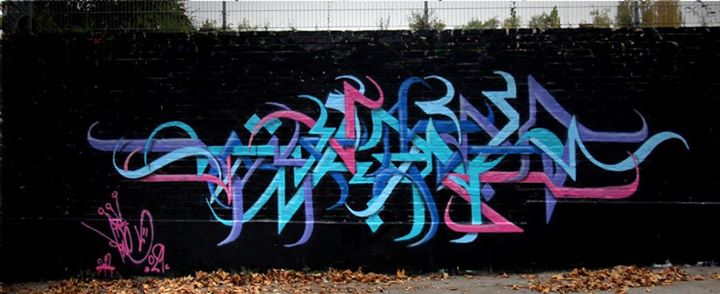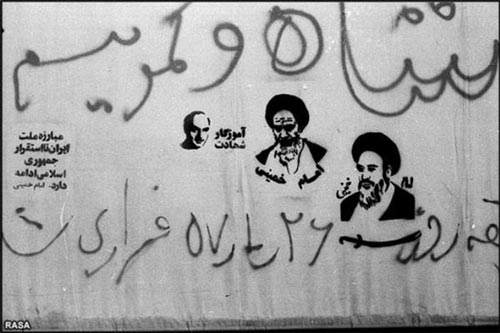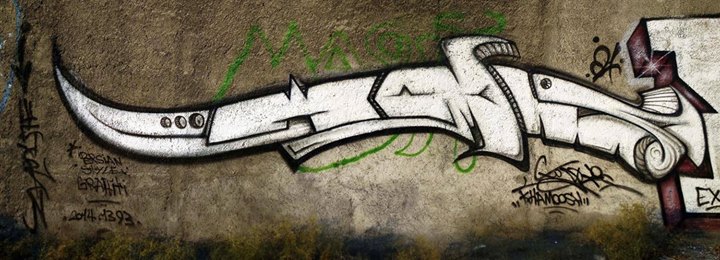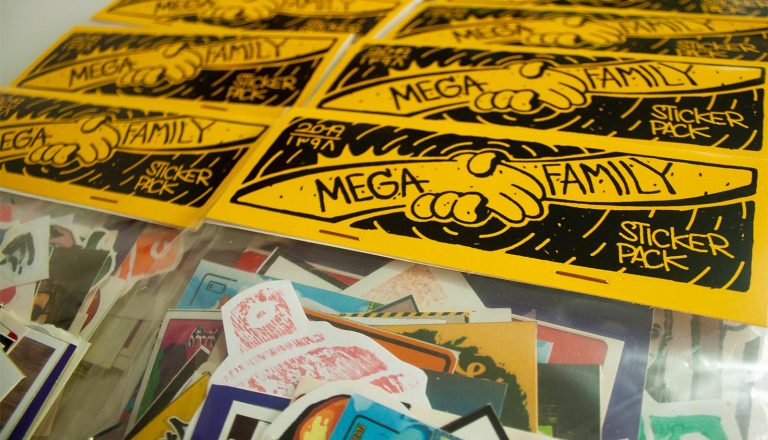
Graffiti in Iran
When I hear comparisons between my home country with other places, I am usually reminded of huge differences but in some rare cases, Iran is not too dissimilar.
It’s the case with graffiti.
As a genre, graffiti may be new art in this country but wall writing, as a tool to protest against the authorities, certainly isn’t. During the overthrow of 1979, anti-government revolutionaries used street walls to spray slogans against the Shah. Following the Islamic revolution, the regime began to use the public space to spray mottos, this time expressing their disdain for communists and western influences. Today, the authorities undertake state-sponsored murals, above highways and on buildings, in an attempt to beautiful the city. The murals however are heavy with themes of religious righteousness, revolutionary ideals and war propaganda. We, as pedestrians and drivers, are commonly visually reminded of the martyrs who died in the eight-year war with Iraq.
In 2009, the citizens turned to the spray can as a weapon for protest again, this time against the authorities for their perceived role in the electoral skullduggery of the presidential election. Mostly, they were removed by the authorities as quickly as they were sprayed
We could say, here in Iran, our revolution has been a spray revolution.

The up side down Typography of “The King”

2 stencils of “Ruhollah Khomeini” leader of the 1979 Iranian Revolution and a stencil of “Ali Shariati” Iranian revolutionary and sociologist
The Start of Iranian Graffiti Culture
Since this time, Iranians have become connected to each other, and the world, through the Internet. The result of which has influenced how our walls are being sprayed. Graffiti in Iran became street art and it developed into a local urban visual culture grounded in a protest movement.
-A1one- is one of Iran’s first well known graffiti artists. He started his career on the walls of Apadana and Ekbatan town – two of Tehran’s sprawling high-rise housing estates. He was the first to employ Farsi typography, developing a style that influenced other artists including -CK1-, -ELLE-, -Magoi-, -Big cheese- and -Pig-. With this, graffiti became a street art movement in Iran.
Khamoosh and the Exit Crew
I interviewed -Khamoosh-. He’s a graffiti writer who uses farsi typography and whose career also began on the walls of Ekbatan and Apadana. He rose to local prominence with an underground exhibition in Tehran in 2011 and has since received international acclaim holding exhibitions in Germany, Italy and America. He has been involved with -Kolah Studio- an underground art collective who have pioneered the urban visual culture in Iran.
-Tell me about the way that cops behave with you? I asked
“There’s no specific crime for graffiti in Iran and it mostly depends on the cops. But the cops come mostly in peace and don’t care about what we’re doing. But it is a crime and they can arrest us as political offenders or as vandals if they choose.”
-What was your last experience with cops.?
“We were working in the canal, then suddenly four cops approached us. They were surprised at first, then they laughed and encouraged us. They asked if we knew about the crime we were committing. I said yes, they laughed again and then left.”
-Khamoosh- is now working with the -Exit- crew; an underground hip hop collective of two Tehrani rappers and one other graffiti writer.
“Our goal is to keep our ideology in line with what we do. Characteristically, the rap is motivated by expressions of protest on the street. We try to keep with this and that is what makes us underground. We don’t let our work get influenced by commercial or government pressures. This only misuses the name of hip hop and makes it vulgar. Hip hop is a lifestyle but unfortunately in Iran, it has become commercial and people, who don’t know anything about the philosophy of graffiti, are getting involved. Here, the mural and street artists are working with government. They have their own mafia and they don’t give a toss about rap or hip hop.

Farsi Typography in the shape of a knife – Khamoosh

Farsi typography(Town) – A1one – on Ekbatan’s wall

Exit – Nirone x Khamoosh
Problems for Graffiti artists in Iran
In the article titled ‘Being a street artist in Iran’ from the Kolah Studio website (one of the major sites of underground art in iran) , it cites three basic problems local graffiti writers regularly encounter. The first, according to this article, is the government’s approach towards graffiti, namely, vandalism or political activist
The second is the prevalence of mural paintings. Artists are employed by the municipalities and must obtain legal permission for their work. Their work is supported by the government in essence, having to pass the standards of heavy censorship, they argue the art is emptied from the critical nature of graffiti. There however does exist mural painters, which I find more authentic, who choose not to become involved with the system. Since they see their art as a means to protest against the authorities, it is uncensored and therefore is saved from being neutered by the system.
Third is the problem of the sprays themselves. Because of trade sanctions, importing spray into Iran is difficult and prohibitively expensive leaving artists to use a locally produced range that of poor quality and limited by choices in color.
The destructive power of Facebook & Art Galleries on Graffiti
Besides all these problems, facebook and art galleries can destroy graffiti,, says Kolah Studio, stemming from Facebook. In the article, the Studio argues Facebook drags people from the streets into an online social network, where separated from its original nature graffiti becomes something defined by a very different aesthetic criterion.
In my own opinion, there also exists a threat to our street movement from art galleries. Gallery owners are tending to invest mostly in works with saleable themes, appropriate for foreign markets, in which they can attract the highest prices. The risk is that the scene will cater to the taste of foreign buyers, and in doing so commercial interests undermine the style and essence of the street art movement.
The whole meaning behind graffiti was to protest against brainwashing and the enslaving of the masses by governments, the media and commercial interests. It is at risk of being lost ….
گرافیتی در ایران
وقتی راجع به مقایسه های بین کشورم با جاهای دیگر چیزهایی میشنوم، معمولا تفاوت های عظیم در ذهنم یادآوری میشوند، اما در برخی مواقع، ایران بسیار هم متفاوت نیست.
این واقعیتی است که درباره ی گرافیتی وجود دارد.
در حقیقت ممکن است گرافیتی یک هنر جدید در این کشور باشد، اما دیوارنویسی بعنوان ابزاری برای اعتراض علیه دولت و قدرت، هنر جدیدی نیست. در طی سرنگونی حکومت پهلوی در سال 1357 ، انقلابی های ضد حکومت از دیوارهای شهر برای اسپری کردن شعارهایشان علیه شاه استفاده میکردند. بعد از انقلاب، رژیم برای اسپری کردن شعارها شروع به استفاده از اماکن عمومی کرد، این بار برای توهین و تحقیر کمونیست ها و تأثیرات غربی.
امروزه، دولت مسئولیت نقاشی های دیواری ای که خود از آن حمایت میکند را با نام زیباسازی شهری بر عهده می گیرد. نقاشی هایی با مضامین مذهبی و پرهیزکارانه، آرمان های انقلابی و تبلیغات راجع به جنگ. بیشتر این تصاویر به ما عابران و رانندگان، شهدای هشت سال جنگ با عراق را یادآوری میکنند.
درسال 1388 شهروندان بار دیگر به اسپری ها بعنوان سلاحی برای اعتراض روی آوردند، شعارها به همان سرعت که اسپری میشدند پاک میشدند.
میتوان گفت، اینجا در ایران، انقلاب ما یک انقلاب اسپری بوده است.

The up side down Typography of “The King”

2 stencils of “Ruhollah Khomeini” leader of the 1979 Iranian Revolution and a stencil of “Ali Shariati” Iranian revolutionary and sociologist
شروع فرهنگ گرافیتی ایرانی
از آن زمان ایرانیان از طریق اینترنت به یکدیگر و به دنیا متصل شده اند و اکنون نتیجه اش طرز اسپری شدن دیوارهایمان است. گرافیتی در ایران تبدیل به هنر خیابانی شد و به یک فرهنگ دیداریِ شهری گسترش یافت، فرهنگی که بر اساس فعالیت های اعتراضی پایه گذاری شده.
یکی از اولین گرافیتی آرتیست های مشهور ایران A1one است. او کار خود را روی دیوارهای شهرک آپادانا و اکباتان شروع کرد، و اولین نفری است که از حروف فارسی استفاده کرد، روشی که هنرمندان دیگری همچون CK1 ، ELLE ، Magoi ، Big Cheese و Pig را تحت تأثیر قرار داد.
بااین کار، گرافیتی به یک جنبش هنری خیابانی در ایران تبدیل شد.
خاموش و اعضای گروه Exit
من با خاموش مصاحبه ای داشتم. او هم گرافیتی آرتیستی است که از حروف فارسی استفاده میکند و کار خود را روی دیوارهای اکباتان و آپادانا شروع کرد. او با یک نمایشگاه زیرزمینی در تهران در سال 1389 به یک امتیاز محلی دست یافت و از آن پس با برگزاری نمایشگاه هایی در آلمان، ایتالیا و آمریکا تحسین های بین المللی بسیاری دریافت کرده است. او با “کلاه استودیو” -یک تشکل زیرزمینی که در فرهنگ دیداری شهری در ایران پیشقدم شده است- همکاری میکند.
پلیس چگونه با شما برخورد میکند؟
در ایران برای گرافیتی جرم مشخصی وجود ندارد و بیشتر به پلیس بستگی دارد. اکثر اوقات با ملایمت برخورد میکنند و اهمیت نمیدهند که ما چه کاری انجام میدهیم. اما به هرحال این یک جرم است و آنها اگر بخواهند میتوانند ما را بعنوان معترضان سیاسی یا خرابکار دستگیر کنند.
آخرین تجربه ات با پلیس ها چه بود؟
ما در یک کانال فاضلاب مشغول کار بودیم که ناگهان چهار پلیس به ما نزدیک شدند. در ابتدا تعجب کردند و بعد خندیدند و تشویقمان کردند. آنها پرسیدند که آیا راجع به جرمی که درحال ارتکاب هستیم چیزی میدانیم یانه، من گفتم بله، و آنها دوباره خندیدند و رفتند.
خاموش درحال حاضر با گروه Exit کار میکند، یک اجتماع زیرزمینی هیپ هاپی از دو رپر تهرانی و یک گرافیتی آرتیست دیگر. او میگوید:
هدف ما این است که عقیده مان را در مسیری که کار میکنیم نگاه داریم. مشخصاً، رپ با اعتراضاتی که در خیابان بیان میشوند برانگیخته شده است. ما سعی میکنیم همین را حفظ کنیم و این چیزی است که ما را “زیرزمینی” کرده است. ما نمیگذاریم کارمان تحت تأثیر تجارت یا فشارهای دولت قرار بگیرد، زیرا با این کار فقط از اسم هیپ هاپ سوء استفاده میشود و آن را خوار میکند. هیپ هاپ یک سبک زندگی است اما متأسفانه در ایران یک حالت تجاری به خود گرفته است و مردمی که هیچ اطلاعی از فلسفه ی گرافیتی ندارند، درحال وارد شدن به این عرصه هستند. اینجا نقاشی ها و هنرمندان با دولت کار میکنند. آنها سازمان های خود را دارند و هیچ اهمیتی به رپ یا هیپ هاپ نمیدهند.

Farsi Typography in the shape of a knife – Khamoosh

Farsi typography(Town) – A1one – on Ekbatan’s wall

Exit – Nirone x Khamoosh
مشکلات گرافیتی آرتیست ها در ایران
در وبسایت کلاه استودیو (یکی از بزرگترین سایت های هنر زیرزمینی در ایران) بندی با عنوان “هنرمند شهری بودن در ایران” وجود دارد که در آنجا به سه مشکل اصلی ای که گرافیتی کار ها ممکن است مرتباً با آنها روبرو شوند اشاره شده است.
اولین مشکل دسترسی دولت به گرافیتی و امکان دستگیری هنرمندان است، با نام خرابکار یا فعال سیاسی.
دومین مشکل رواج نقاشی های دیواری است، هنرمندان توسط شهرداری ها استخدام شده اند و باید برای کارشان مجوز قانونی بگیرند. دراصل کار آنها توسط دولت حمایت میشود، درحالیکه مجبورند از فیلتر استانداردهای سانسورهای سنگین عبور کنند و آثار آنها خالی از ذات منتقدانه ی گرافیتی است. باوجود اینها هنوز هم نقاشان دیواری ای هستند که قابل اعتماد تر باشند، هنرمندانی که خود را درگیر سیستم نکرده اند و از وقتی که دیده اند هنرشان وسیله ای برای اعتراض به دولت است، آن را سانسور نشده ارائه داده اند و از خنثی شدنش توسط سیستم محافظت کرده اند.
سومین مشکل خود اسپری ها هستند. به دلیل تحریم های تجاری، وارد کردن اسپری به ایران سخت است و این امر هنرمندان را به استفاده از اسپری های تولید داخلی که با کیفیت پایین و رنگ های محدود موجود هستند وادار میکند.
اثرات مخرب فیس بوک و گالری های هنری بر گرافیتی
کلاه استودیو در نتیجه گیری از اثرات مخرب فیس بوک میگوید:
در کنار تمام این مشکلات، فیس بوک و گالری های هنری میتوانند گرافیتی را نابود کنند. فیس بوک مردم را از خیابان ها به یک شبکه ی اجتماعی آنلاین می کشاند، جایی که گرافیتی از اصل واقعی خود جدا میشود و تبدیل به یک چیز تعریف شده توسط یک معیار کاملا متفاوت و ظریف طبعانه میشود.
به عقیده ی من با وجود گالری های هنری یک تهدید برای جنبش خیابانی ما وجود دارد. صاحبان گالری ها درحال گرایش به سرمایه گذاری کردن روی کارهایی هستند که مضمون های قابل فروش داشته باشند و مختص بازاهای خارجی باشند، که در اینصورت بتوانند بالاترین قیمت ها را جذب کنند. خطر اینجاست که این کار به مزاج خریداران خارجی خوش بیاید، و باعث تجارت هایی شود که ماهیت و شکل جنبش هنر خیابانی را از پایه خراب کنند. تمام معنا و هدف پنهان شده در پس گرافیتی، اعتراض علیه شست و شوی مغزی و اسارت مردم توسط دولت ها، رسانه و منافع تجاری است. این هدف در خطر از دست رفتن است









